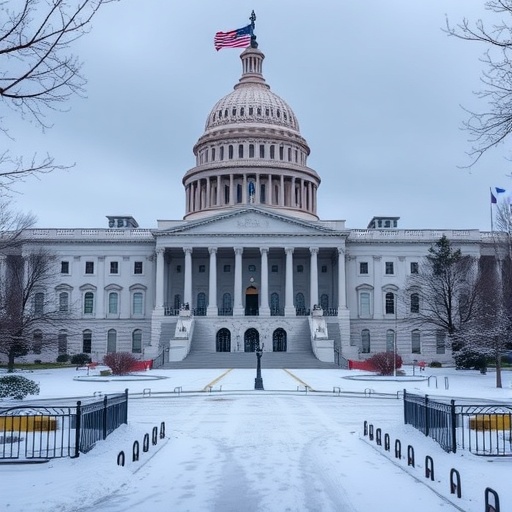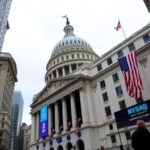As the United States teeters on the brink of its longest Government shutdown in history, federal workers brace for continued uncertainty while the economy faces mounting pressures. With the current impasse now stretching into its 35th day, surpassing the 1995-1996 record of 21 days, Republicans and Democrats remain deadlocked over key budget provisions, delaying critical data releases like the monthly jobs report and raising alarms about broader fiscal fallout.
Budget Standoff Deepens: Core Disputes Fueling the Shutdown
The roots of this prolonged Government shutdown lie in a fierce partisan divide over the federal budget, where Republicans demand spending cuts and border security enhancements, while Democrats push for increased funding in social programs and disaster relief. At the heart of the disagreement is a proposed $5.7 billion allocation for border wall construction, a signature issue for President Donald Trump, who has vowed not to sign any budget bill without it. House Speaker Nancy Pelosi, leading Democratic efforts, has steadfastly refused to include such funding, arguing it diverts resources from pressing needs like healthcare and education.
“This isn’t about walls; it’s about values,” Pelosi stated in a recent press conference, emphasizing the Democrats’ commitment to comprehensive immigration reform over what she called “divisive symbolism.” On the Republican side, Senate Majority Leader Mitch McConnell has echoed Trump’s stance, warning that yielding on border security would betray the party’s base. Negotiations in Congress have yielded little progress, with multiple continuing resolutions failing to bridge the gap. According to the Congressional Budget Office (CBO), the ongoing shutdown has already cost the government over $11 billion in potential economic activity, a figure that climbs daily as non-essential services remain halted.
Key sticking points include not only the border wall but also debates over defense spending, which Republicans seek to bolster amid global tensions, and environmental initiatives championed by Democrats. The impasse has forced lawmakers into repeated closed-door sessions, but sources close to the talks indicate frustration is mounting on both sides. As one anonymous GOP aide told reporters, “We’re all feeling the heat from constituents back home—nobody wants to be the villain in this fiscal drama.”
Federal Workers Feel the Squeeze: Personal Stories from the Shutdown Frontlines
Beyond the political rhetoric, the Government shutdown‘s human cost is becoming increasingly apparent. Over 800,000 federal employees are either furloughed without pay or working without compensation, affecting agencies from the Department of Homeland Security to the National Park Service. In Washington, D.C., scenes of shuttered monuments and empty office buildings underscore the disruption, while families across the country grapple with delayed paychecks.
Take Sarah Jenkins, a 42-year-old IRS auditor from Virginia, who has been furloughed for weeks. “I’ve had to dip into savings just to cover groceries,” Jenkins shared in an interview with The Daily Chronicle. “It’s not just about the money—it’s the uncertainty. Will I get back pay? How long can this go on?” Her story is echoed by thousands: air traffic controllers at the FAA risking burnout without hazard pay, and Smithsonian curators watching priceless artifacts gather dust.
The economic ripple effects extend to contractors and small businesses reliant on government contracts. A report from the Partnership for Public Service estimates that the shutdown could lead to $3 billion in lost wages for federal workers alone by the end of the month. Moreover, food assistance programs like SNAP face processing delays, potentially leaving vulnerable populations without timely aid. Republicans have blamed Democrats for the stalemate, with Trump tweeting, “Democrats are holding the country hostage over open borders—time to end this nonsense!” Democrats counter that the shutdown is a manufactured crisis by the administration to force unpopular policies.
- Furloughed Employees: Approximately 380,000 civilian defense workers and 420,000 from other agencies.
- Working Without Pay: Essential personnel in law enforcement and security continue operations amid financial strain.
- Back Pay Promises: Congress has assured retroactive compensation once resolved, but timing remains unclear.
Public sentiment is shifting, with polls from Gallup showing 53% of Americans disapproving of the shutdown’s handling, up from 45% at its onset. This pressure could influence midterm election dynamics, as both parties eye voter backlash.
Jobs Report Delay Ignites Economic Uncertainty and Market Volatility
One of the most immediate casualties of the government shutdown is the delayed release of the highly anticipated monthly jobs report from the Bureau of Labor Statistics (BLS). Originally scheduled for January 4, the report—crucial for gauging unemployment rates, wage growth, and hiring trends—has been postponed indefinitely due to furloughed economists and data processors. Economists warn that this blackout of vital information could exacerbate market jitters at a time when global trade tensions already loom large.
“The jobs report is the economy’s heartbeat,” said Mark Zandi, chief economist at Moody’s Analytics, in a recent op-ed. “Without it, investors are flying blind, and that breeds volatility.” Indeed, Wall Street has reacted sharply: the Dow Jones Industrial Average dipped 1.2% in the days following the announcement, with tech stocks particularly vulnerable amid fears of slowed consumer spending. The shutdown’s timing is especially unfortunate, coinciding with year-end tax season preparations and federal lending programs that support small businesses.
Broader economic impacts are mounting. The CBO projects a 0.1% hit to fourth-quarter GDP growth, potentially shaving points off the nation’s expansion. Consumer confidence indices, like the Conference Board’s, have fallen to their lowest since 2017, as households delay big purchases amid uncertainty. In sectors like travel and tourism, national parks’ closures have cost an estimated $500 million in lost revenue, according to the U.S. Travel Association.
Republicans argue that the economic pain underscores the need for swift resolution on their terms, while Democrats point to the shutdown as evidence of fiscal irresponsibility. Treasury Secretary Steven Mnuchin has urged bipartisan compromise, stating, “We can’t let politics derail the recovery we’ve built.” Yet, with the debt ceiling approaching in March, analysts fear this could cascade into a triple-threat scenario of shutdown, debt limit, and budget battles.
Looking Ahead: Pathways to End the Shutdown and Avert Deeper Crisis
As the government shutdown surpasses previous records, eyes turn to potential breakthroughs that could restore normalcy. Bipartisan talks in the Senate, led by figures like Lindsey Graham (R-SC) and Chuck Schumer (D-NY), are exploring compromise packages that might include temporary wall funding tied to immigration reforms. President Trump has hinted at flexibility, suggesting in a Fox News interview, “If Democrats come to the table with real solutions, we can make a deal—America first.”
However, challenges persist. Any agreement must navigate House approval, where Pelosi’s slim majority holds sway. External pressures, including warnings from international allies about U.S. reliability and domestic protests by federal workers, are amplifying calls for action. The U.S. Chamber of Commerce has lobbied intensely, estimating that prolonged closure could cost 1.5 million private-sector jobs if it extends into February.
Forward-looking scenarios include a short-term funding bill to reopen government while negotiations continue, or escalation if Trump declares a national emergency—a move Democrats vow to challenge in court. Economists like those at the Federal Reserve predict that resolution by mid-January could limit damage, but delays risk tipping the economy toward recessionary signals. As lawmakers reconvene this week, the stakes couldn’t be higher: not just for the budget and jobs report, but for public trust in governance itself. The path forward demands unprecedented cooperation between Republicans and Democrats to prevent history’s longest shutdown from becoming a defining chapter in American fiscal woes.









